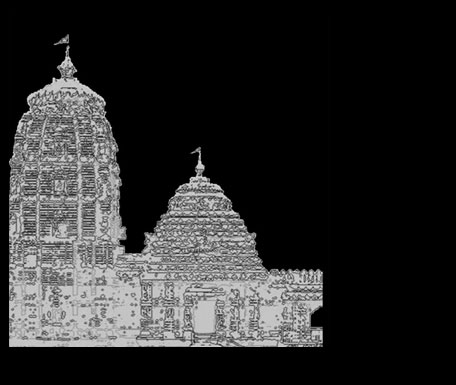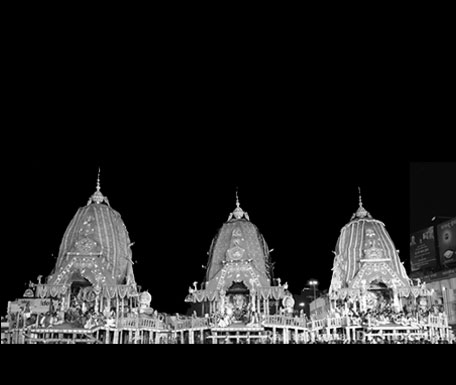





"Vakratunda Mahakaya Suryakoti Samaprabha
NirvighnamKuruMey Deva SarvaKaaryeshuSarvada"
The Lord of success, the destroyer of evils and the protector against adversity- Lord Ganesha the Vighneswara is a non-sectarian deity, most widely worshipped by almost all sects, casts and in all parts of the country. Lord Ganesha is also noticed in other countries like in Japan, China, Srilanka, Nepal & Mangolia. Variously believed as Lord of knowledge, wisdom, wealth, prosperity, auspiciousness, self- control-a cosmic reality of Shiva and Shakti is a Devine experience.
Ganesha Puja/ festival is observed in the Hindu calendar month of 'Bhadrapada' starting on Shukla Chaturthi (fourth day of waxing moon period bright fort-night) and ending on Ananta Chaturdasi the fourteenth day. The festival typically falls in the month of August/ September every year. It is believed, Ganesha was born on this day.
The image/idol of Lord Ganesha is easily identifiable with elephant head, human body with four arms, a big belly and a rat as a Vahana (mount / Vehicle). Every body parts of Lord Ganesha convey deep meanings. Large head and ears means wisdom is gained through listening and reflecting on eternal truth of Vedas. The curved trunk in shape of OM, the sound of cosmic reality is our most powerful mantra in prayer and meditation. The trunk signifies the need for us to develop our intellect, power of discrimination, efficiency and adaptability in the material and spiritual world. The goad or Ankush in upper right hand to tame and control our mind and be above all bonds of attachment. The noose or paasa in left upper hand signifies the need to pull one nearer to the highest goal. The small eyes to concentrate contemplate and meditate. The right lower upraised arm symbolises protection and sanctuary. Modak (sweet) in lower left arm represent Mokshya, Liberation and the reward for sadhana. The large belly is said to contain the whole universe- and is symbolic of the way we should live our lives. We must be able to peacefully digest all good and bad of life, all trials and tribulations in equal mindedness. The little rat the Mooshikam represents desire and we should keep the desire under control at our feet never allowing desire to overwhelm us like Lord Ganesh. The small mouth conveys that talk less and the tusk to retain good and discard the bad. At the feet of the Lord is offer spread on array of food representing material Wealth, Power, Prosperity which indicate that they are available to you if you lead a life of ideals and principles.
Lord Ganesha sits with one leg folded up and the other leg resting on the ground. The leg on the ground tells that we can live in this materialistic would but nothing should pollute us like a lotus grows in stagnant water. The other leg pointing upwards means we should elevate our soul through meditation and good thoughts to attain the supreme and ultimate reality. One can go into the spiritual path through worship of Lord Ganesha to control jealousy, illusion, drunkenness, greed, anger, desire, ego and self-infatuation. Lord Ganesha is Lord of Love, wisdom and action.
The birth of Ganesha the son of Lord Shiva and Parvathi are narrated in several puranic and mythological anecdotes. The most well-known and popular Version goes as follows.
One day Goddess Parvathi was at home on Mt. Kaillash preparing for a bath. As she didn't want to be disturbed, she told Nandi, her husband Shiva's bull, to guard the door and let no one pass. Nandi faithfully took his post, intending to carry out Parvathi's wishes. But, when Shiva came home and naturally wanted to come inside, Nandi had to let him pass, being loyal first to Shiva. Parvathi was angry at this slight, but even more than this, at the fact that she had no one as loyal to herself as Nandi was to Shiva. So, taking the turmeric paste (for bathing) from her body and breathing life into it, she created Ganesha, declaring him to be her own loyal son.
The next time Parvathi wished to bathe, she posted Ganesha on guard duty at the door. In due course, Shiva came home, only to find this strange boy telling him he couldn't enter his own house. Furious, Shiva ordered his army to destroy the boy, but they all failed. Such power did Ganesha possess, being the son of Devi Herself.
This surprised Shiva. Seeing that this was no ordinary boy, the usually peaceful Shiva decided he would have to fight him, and in his divine fury severed Ganesha's head, killing him instantly. When Parvathi learned of this, she was so enraged and insulted that she decided to destroy the entire Creation. Lord Brahma, being the Creator, naturally had issues with this, and pleaded that she reconsiders her drastic plan. She said she would, but only if two conditions were met. One that Ganesha be brought back to life, and two, that he be forever worshipped before all the other Gods.
Shiva, having cooled down by this time, and realizing his mistake, agreed to Parvathi's conditions. He sent Brahma out with orders to bring back the head of the first creature he crosses that is lying with its head facing north. Brahma soon returned with the head of a strong and powerful elephant, which Shiva placed onto Ganesha's body. Breathing new life into him, he declared Ganesha to be this own son as well, and gave him the status of being foremost among the Gods and leader of all the ganas (classes of beings), Ganapati.
However, there's another less popular story of his origin, found in the Brahma Vaivarta Purana: Shiva asked Parvathi to observe the punyakavrata for a year to appease Vishnu in order to have a son. When a son was born to her, all the Gods and Goddesses assembled to rejoice on its birth. Lord Shani, the son of Surya (Sun-God), was also present but he refused to look at the infant. Perturbed at this behavior, Parvathi asked him the reason, and Shani replied that his looking at body, the child's head was severed instantly. All the Gods started to bemoan, where upon Vishnu hurried to the bank of river Pushpabhadra and brought back the head of a young elephant and joined it to the baby's body, thus reviving it.
According to Ganesha Purana four Ganesha incarnations came on earth during different period (Yugas) in order to fight the devils, Ganesha appeared as MAHOTKATA with ten arms seated on a lion to kill the demons Navantak and Devantak in Krita Yuga. As SRI MAYURESVAR with six arms white coloured riding on a peacock faced the demon Sindhu during Tretya Yuga. Red colour Shri Ganesha with four arms mounted on rat destroyed the demon Sindur during Dwapara Yuga. Will appear as Dhumarketu riding a blue hosre to fight all evils in Kali Yuga. MudgalaPurana describes eight incarnations of Ganesha. Ganesha uses a mouse in five of them, a lion in his incarnation as Vakratunda, a peacock in his carnation as Vikata and Shesha the divine serpent in his incarnation as Vighnaraj. Jain depictions of Ganesha show his vahana variously as mouse, elephant, tortoise, ram or peacock.
Ganesha emerged as a distinct deity in the 4th and 5th centuries C.E. during the Gupta period, although the inherited traits from Vedic and pre-Vedic precursors. He was formally included among the five primary deities of Smartism (Brahma, Vishnu, Maheswara, Durga& Ganesha) in the 9th century.
Lord Ganesha is worshipped and prayed through 108 names & with utmost devotion. Akrutha, Amit, Avaneesh, Avigno, Bakratunda, Bheema, Bhupati, Bhuvanpati, Buddhinam, Buddhipriya, Chaturbhuja, Devadava, Devavrata, Dharmik, Dhumaketu, Ekakshara, Ekadanta, Gajanana, Kapil, Kirti, Lambodara, Mahodara, Mangalmurti, Nandana, Sumukha, Swaroop, Tarun, Vinayaka, Vighneswara, Vikat, Viswaraj, Vighnarajaetc are few of these 108 names of the Lord.
The modern festival involves installing clay images of Ganesha in public pandals (temporary shrines), which are worshipped for ten days with different variety of herbal leaves, plants. These are immersed at the end of the festival in a body of water such as a lake, along with the idol. After adding herbal and medicated plants and leaves (patri) in lakes, the water in the lake becomes purified. This was in practice because, in early days people used to drink lake water, and to protect people from infections and viral diseases especially in this season. Some Hindus also install the clay images of Ganesha in their homes. It is believed that Ganesha bestows his presence on earth for all his devotees during this festival. The festival celebrated as a public event since the days of Maratha King Shivaji (1630-1680). However, the public festival as celebrated in Maharashtra today, was introduced by BhausahebLaxmanJavale in 1892 by installing first Sarvajanik (Public) Ganesha idol ShrimantBhausahebRangariGanapati, Bhudwar Peth, in Pune. 1st meeting regarding starting the Sarvajanik Ganesha Utsav took place under the leadership of BhausahebLaxmanJavale at his residence (Bhudwar Peth) now known as BhauRangari Bhavan. In 1893 Lokamany Tilak praised the concept of Sarvajanik Ganesha Utsav in Kesari Newspaper. In 1894 Nationalist Leader Lokamany Tilak installed Ganesha idol in Kesariwada, Pune too and started preaching Ganesha Utsav.
While celebrated all over India, it is grandest and most elaborate in Maharashtra, Karnataka and Hyderabad which lasts for 10 days, ending on the day of Ananta Chaturdashi.
Let us pray, invoke and surrender to Lord Vighneswara, the most auspicious of God of new beginning for the peace & prosperity of mankind.